- Sale Price
- 999$
- Location
- United States
Item Name: FS Large Gun Collection, WINCHESTER, NORINCO SKS'S AND AK, ENFIELD, GERMAN & BELGIAN MAUSERS
Location: Shawnee
Zip Code: 74804
Item is for: Sale Only
Sale Price: 999
Willing to Ship: No
Bill of Sale Required?: No
Item Description: Hello, I am trying to raise money to pay bills after my father passed away from complications of a stint operation. While he was in the hospital dying my parents home burned and was severely damaged. Luckily he never knew his home burned or that his pets died. Anyways, my mom has a lengthy bill list on top of everything. We are lucky there was a shop and gun safe to store most of the guns. Now I am selling his military memorabilia and gun collection. These are a few I have already made a list of and taken photos. I really appreciate any help.
ONEDRIVE LINK WITH PHOTOS OF ALL GUNS IN LIST
https://1drv.ms/a/s!AoGyziBpYm_Ejg6-2XXnQWwzOBmD
CHINESE NORINCO KSI MAK-90 MILLED SPORTER AK47 VARIANT 7.62X39 NEW IN BOX UNFIRED K-SPORTS IMPORTS $1,200.00
CHINESE NORINCO SKS-M 7.62X39 NEW IN BOX UNFIRED. USES AK47 MAGAZINES $775.00
CHINESE SKS M21 7.62X39 NEW IN BOX UNFIRED WITH BAYONET $600.00
CHINESE NORINCO SKS SPORTER 7.62X39 NEW IN BOX UN FIRED USES AK47 MAGAZINES $775.00
ENFIELD NO4 MK2 {F} .303 BRITISH 9/49 MADE IN UNITED KINGDOM. MATCHIG PARTS. MAGAZINE SERIAL IS PF149884 In the years after the Second World War the British produced the No. 4 Mk 2 (Arabic numerals replaced Roman numerals for official designations in 1944) rifle, a refined and improved No. 4 rifle with the trigger hung forward from the butt collar and not from the trigger guard, beech wood stocks (with the original reinforcing strap and centre piece of wood in the rear of the forestock on the No.4 Mk I/Mk I* being removed in favour of a tie screw and nut) and brass buttplates (during World War II, the British replaced the brass buttplates on the No.4 rifles with zinc alloy (Zamak) ones to reduce costs and to speed up rifle production) $475.00
SOLD ENFIELD NO4 MK1 (F) .303 BRITISH 8/48 MADE IN THE UNITED KINGDOM. MATCHING PARTS INCLUDING MAGAZINE. By the late 1930s the need for new rifles grew and the Rifle, No. 4 Mk I was officially adopted in 1941.[32] The No. 4 action was similar to the Mk VI, but lighter, stronger, and most importantly, easier to mass-produce.[33] Unlike the SMLE, that had a nose cap, the No 4 Lee–Enfield barrel protruded from the end of the forestock. The charger bridge was no longer rounded for easier machining. The iron sight line was redesigned and featured a rear receiver aperture battle sight calibrated for 300 yd (274 m) with an additional ladder aperture sight that could be flipped up and was calibrated for 200–1,300 yd (183–1,189 m) in 100 yd (91 m) increments. This sight line like other aperture sight lines proved to be faster and more accurate than the typical mid-barrel rear sight elements sight lines offered by Mauser, previous Lee–Enfields or the Buffington battle sight of the 1903 Springfield. The No. 4 rifle was heavier than the No. 1 Mk. III, largely due to its heavier barrel and a new bayonet was designed to go with the rifle: a spike bayonet, which was essentially a steel rod with a sharp point and was nicknamed "pigsticker" by soldiers.[33] Towards the end of the Second World War, a bladed bayonet was developed, originally intended for use with the Sten gun—but sharing the same mount as the No. 4's spike bayonet—and subsequently the No. 7 and No. 9 blade bayonets were issued for use with the No. 4 rifle as well.[34] $425.00
ENFIELD NO4 MK1* .303 BRITISH 1942. MARKED. 5 1942 CROWN M 57 46. U.S. PROPERTY MAGAZINE HAS BEEN REMARKED TO MATCH SERIAL. During the course of the Second World War, the No. 4 rifle was further simplified for mass-production with the creation of the No. 4 Mk I* in 1942, with the bolt release catch replaced by a simpler notch on the bolt track of the rifle's receiver.[35] It was produced only in North America, by Long Branch Arsenal in Canada and Savage-Stevens Firearms in the USA $400.00
SOLD ENFIELD NO4 MK1 (F) FTR .303 BRITISH /48 1942. ALL MATCHING PARTS INCLUDING MAGAZINE. NO IMPORT MARKS By the late 1930s the need for new rifles grew and the Rifle, No. 4 Mk I was officially adopted in 1941.[32] The No. 4 action was similar to the Mk VI, but lighter, stronger, and most importantly, easier to mass-produce.[33] Unlike the SMLE, that had a nose cap, the No 4 Lee–Enfield barrel protruded from the end of the forestock. The charger bridge was no longer rounded for easier machining. The iron sight line was redesigned and featured a rear receiver aperture battle sight calibrated for 300 yd (274 m) with an additional ladder aperture sight that could be flipped up and was calibrated for 200–1,300 yd (183–1,189 m) in 100 yd (91 m) increments. This sight line like other aperture sight lines proved to be faster and more accurate than the typical mid-barrel rear sight elements sight lines offered by Mauser, previous Lee–Enfields or the Buffington battle sight of the 1903 Springfield. The No. 4 rifle was heavier than the No. 1 Mk. III, largely due to its heavier barrel and a new bayonet was designed to go with the rifle: a spike bayonet, which was essentially a steel rod with a sharp point and was nicknamed "pigsticker" by soldiers.[33] Towards the end of the Second World War, a bladed bayonet was developed, originally intended for use with the Sten gun—but sharing the same mount as the No. 4's spike bayonet—and subsequently the No. 7 and No. 9 blade bayonets were issued for use with the No. 4 rifle as well.[34] $425.00
ENFIELD NO5 MK1 ROF {F} JUNGLE CARBINE .303 BRITISH 8/45 ROF Fazakerley, Liverpool. MATCHING NUMBERS. NO IMPORT MARKS. The No. 5 was first issued to the British 1st Airborne Division and used during their liberation of Denmark and Norway in 1945. $595.00
ENFIELD NO4 MK1* .303 BRITISH MARKED 5 NO4 MK1* B TRIANGLE BOLT IS RENUMBERED TO MATCH $400.00
WINCHESTER MODEL 1890 BREAKDOWN PUMP .22 SHORT 349803 MADE IN 1908 $869.00
GERMAN G.33/40 MAUSER GERMAN MOINTAIN TROOP CARBINE 8X57 MAUSER NO IMPORT MARKS. DOT 1942. BOLT SERIAL DOES NOT MATCH. BOLT IS A CORRECT G.33/40 FRONT TOP HANDGUARD SERIAL MATCHES. ORIGINAL SLING Gewehr 33/40 (t) Production of a slightly modified version continued during the German occupation of Czechoslovakia for the German armed forces. This version was 5 mm longer (due to a different buttplate), a metal plate was attached to the left side of the gunstock and with a German type sling and laminated stock fitted this rifle was issued to German mountain troops as the Gewehr 33/40 (t) ('t' being the national origin designator tschechoslowakisch, the German word for 'Czechoslovak'; such national origin designators were German practice for all foreign weapons taken into service). Markings are of the German type, with code letters on the receiver ring in place of the Czech rampant lion.
From 1940 until 1942 another 131,503 of the Gewehr 33/40 (t) variant were produced for the German army: 29,000 Gewehr 33/40 (t) were produced in 1940, 48,049 Gewehr 33/40 (t) were produced in 1941 and 54,454 Gewehr 33/40 (t) were produced in 1942.[2] The German armed forces also used the rifles previously issued to the Czechoslovak military. A few prototypes of G 33/40 (t) with wooden folding stocks were also produced for the German paratroopers, not shown in above totals, but this variant never went into serial production.[3] $1,979.00
GERMAN G.33/40 MAUSER GERMAN MOINTAIN TROOP CARBINE 8X57 MAUSER 2011 NO IMPORT MARKS. MISSING TOP HANDGUARD. BOLT SERISL DOESN'T MATCH. BOLT IS A CORRECT G.33/40 PART. DOT 1942 Gewehr 33/40 (t) Production of a slightly modified version continued during the German occupation of Czechoslovakia for the German armed forces. This version was 5 mm longer (due to a different buttplate), a metal plate was attached to the left side of the gunstock and with a German type sling and laminated stock fitted this rifle was issued to German mountain troops as the Gewehr 33/40 (t) ('t' being the national origin designator tschechoslowakisch, the German word for 'Czechoslovak'; such national origin designators were German practice for all foreign weapons taken into service). Markings are of the German type, with code letters on the receiver ring in place of the Czech rampant lion.
From 1940 until 1942 another 131,503 of the Gewehr 33/40 (t) variant were produced for the German army: 29,000 Gewehr 33/40 (t) were produced in 1940, 48,049 Gewehr 33/40 (t) were produced in 1941 and 54,454 Gewehr 33/40 (t) were produced in 1942.[2] The German armed forces also used the rifles previously issued to the Czechoslovak military. A few prototypes of G 33/40 (t) with wooden folding stocks were also produced for the German paratroopers, not shown in above totals, but this variant never went into serial production.[3] $1,329.00
BELGIAN M1889/36 MAUSER SHORT RIFLE 7.65X53 7400 WW2 Belgium Army. NO IMPORT MARKS In 1936 in order to standardize along the lines of the models 1935 Short Rifle, conversion of the stocks of model 1889 Rifles and Carbines commenced in the factory of Pieper and Cie. in Herstal as well as at the Manufacture d'armes de L'Etat and continued until 1940. The resulting rifle combined the action and the shorted stock of the Model 1889 with the barrel, sights, forend, and hinged upper barrel band of the Model 1935 Short rifle. In order to strengthen the stock, a recoil bolt was also incorporated through the stock beneath the chamber, just forward of the magazine.
A small number of Belgian M1889 rifle and carbines were converted to the model 1889/36 Short Rifle configuration by a Liege firm known as "Anciens Establishment Pieper", which like FN itself, was located in Herstal near Liege, Belgium. Pieper conversions are marked with an abbreviated form of the Pieper corporate name over the name of the town "Herstal". The Mauser Model 1889/36 rifles began production in 1936 at Manufacture d’Armes de l’Etat (MAE) and ran until 1940 using existing full length 1889 rifles. Original carbines were not fit for this transition and this may be why they exist in such quantities today. Another contract was filled by the commercial firm Anciens Establishment Pieper during 1939/1940. The Pieper rifles appear to have used Model 1889 carbine parts as well as rifles, showing spliced stocks and occasionally bent or checkered bolt handles.
Changes to the Model 1889 were severe. While the receiver was kept, almost everything else was replaced or altered as listed below.
The jacketed barrel was tossed and replaced with a Model 1935 barrel and sights.
Stocks were shortened to accommodate the new barrel length.
Wood shims were installed to support the smaller, unjacketed barrel.
Handguards were made to match.
Plugs were inserted under the bolt release with new serial stampings.
New barrel bands, sling swivels, and bayonet lugs were installed.
In an incredible display of recycling the original bolt bodies were kept and modified to accept the Model 1898 style bolt sleeves. This creates an interesting two lug bolt with a modern looking Mauser sleeve and safety at the rear.
The cartouche on the stock indicates that it was rebuilt by the government arsenal Manufacture d”Etat in 1936. I say rebuilt because these rifles were the Belgium Army’s attempt to modernize their old M1889 Mauser rifles up to 1930’s standards. The rework was extensive and basically created a completely new much shorter modernized rifle. After the defeat of 1940 these rifles were surrendered to the Germans. They were extensively used by German collaborators and the Luftwaffe in Belgium and later in the war also by the Volksturm. These rifles are scarce and you never see them and this would be a great addition to any WW2 Collection. $1,259.00
Pictures:
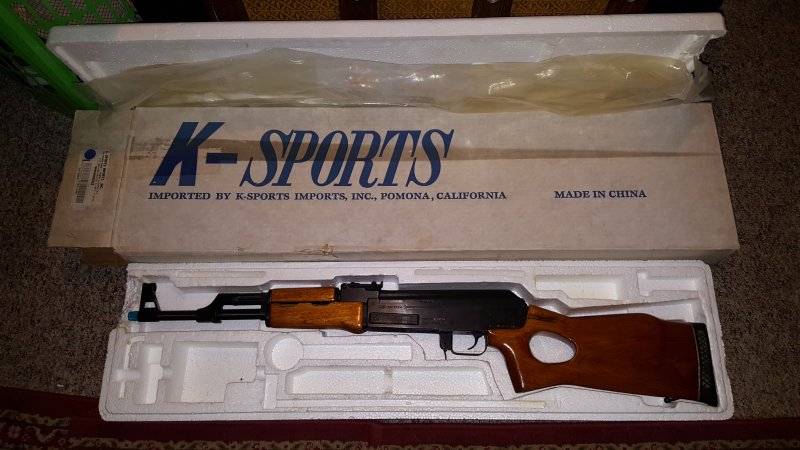
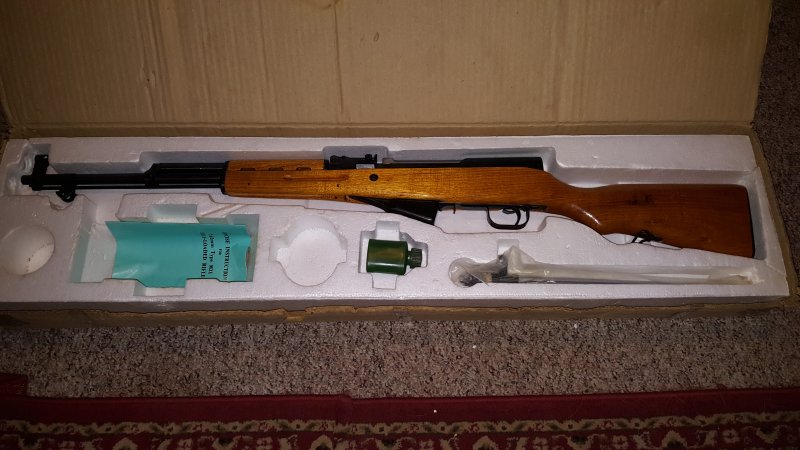
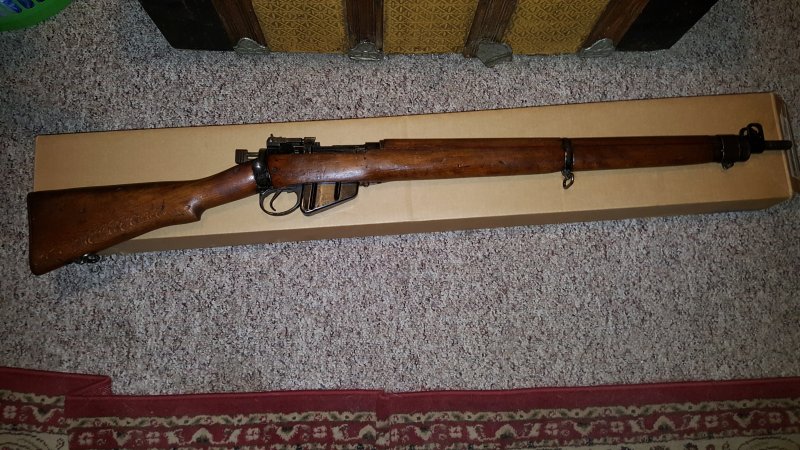
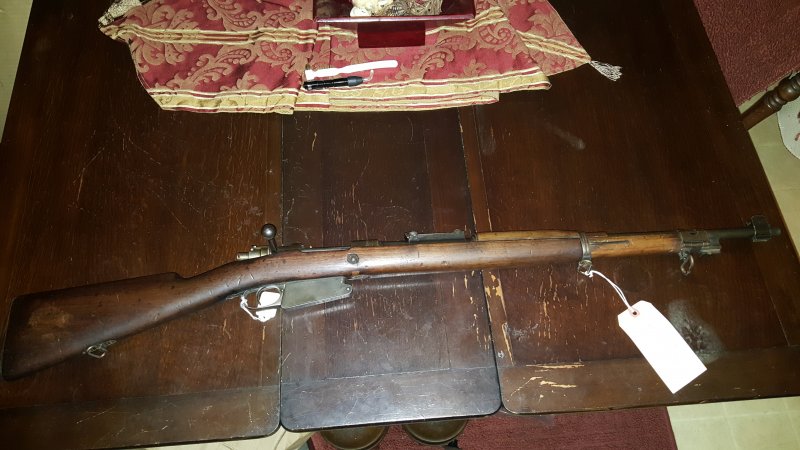
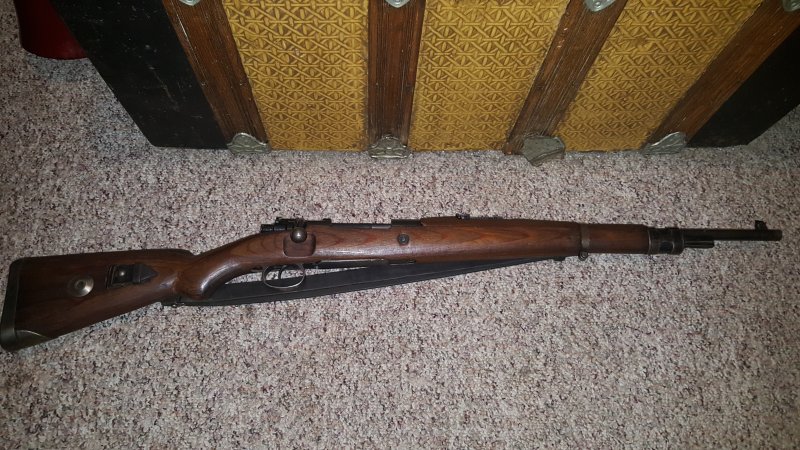
Location: Shawnee
Zip Code: 74804
Item is for: Sale Only
Sale Price: 999
Willing to Ship: No
Bill of Sale Required?: No
Item Description: Hello, I am trying to raise money to pay bills after my father passed away from complications of a stint operation. While he was in the hospital dying my parents home burned and was severely damaged. Luckily he never knew his home burned or that his pets died. Anyways, my mom has a lengthy bill list on top of everything. We are lucky there was a shop and gun safe to store most of the guns. Now I am selling his military memorabilia and gun collection. These are a few I have already made a list of and taken photos. I really appreciate any help.
ONEDRIVE LINK WITH PHOTOS OF ALL GUNS IN LIST
https://1drv.ms/a/s!AoGyziBpYm_Ejg6-2XXnQWwzOBmD
CHINESE NORINCO KSI MAK-90 MILLED SPORTER AK47 VARIANT 7.62X39 NEW IN BOX UNFIRED K-SPORTS IMPORTS $1,200.00
CHINESE NORINCO SKS-M 7.62X39 NEW IN BOX UNFIRED. USES AK47 MAGAZINES $775.00
CHINESE SKS M21 7.62X39 NEW IN BOX UNFIRED WITH BAYONET $600.00
CHINESE NORINCO SKS SPORTER 7.62X39 NEW IN BOX UN FIRED USES AK47 MAGAZINES $775.00
ENFIELD NO4 MK2 {F} .303 BRITISH 9/49 MADE IN UNITED KINGDOM. MATCHIG PARTS. MAGAZINE SERIAL IS PF149884 In the years after the Second World War the British produced the No. 4 Mk 2 (Arabic numerals replaced Roman numerals for official designations in 1944) rifle, a refined and improved No. 4 rifle with the trigger hung forward from the butt collar and not from the trigger guard, beech wood stocks (with the original reinforcing strap and centre piece of wood in the rear of the forestock on the No.4 Mk I/Mk I* being removed in favour of a tie screw and nut) and brass buttplates (during World War II, the British replaced the brass buttplates on the No.4 rifles with zinc alloy (Zamak) ones to reduce costs and to speed up rifle production) $475.00
SOLD ENFIELD NO4 MK1 (F) .303 BRITISH 8/48 MADE IN THE UNITED KINGDOM. MATCHING PARTS INCLUDING MAGAZINE. By the late 1930s the need for new rifles grew and the Rifle, No. 4 Mk I was officially adopted in 1941.[32] The No. 4 action was similar to the Mk VI, but lighter, stronger, and most importantly, easier to mass-produce.[33] Unlike the SMLE, that had a nose cap, the No 4 Lee–Enfield barrel protruded from the end of the forestock. The charger bridge was no longer rounded for easier machining. The iron sight line was redesigned and featured a rear receiver aperture battle sight calibrated for 300 yd (274 m) with an additional ladder aperture sight that could be flipped up and was calibrated for 200–1,300 yd (183–1,189 m) in 100 yd (91 m) increments. This sight line like other aperture sight lines proved to be faster and more accurate than the typical mid-barrel rear sight elements sight lines offered by Mauser, previous Lee–Enfields or the Buffington battle sight of the 1903 Springfield. The No. 4 rifle was heavier than the No. 1 Mk. III, largely due to its heavier barrel and a new bayonet was designed to go with the rifle: a spike bayonet, which was essentially a steel rod with a sharp point and was nicknamed "pigsticker" by soldiers.[33] Towards the end of the Second World War, a bladed bayonet was developed, originally intended for use with the Sten gun—but sharing the same mount as the No. 4's spike bayonet—and subsequently the No. 7 and No. 9 blade bayonets were issued for use with the No. 4 rifle as well.[34] $425.00
ENFIELD NO4 MK1* .303 BRITISH 1942. MARKED. 5 1942 CROWN M 57 46. U.S. PROPERTY MAGAZINE HAS BEEN REMARKED TO MATCH SERIAL. During the course of the Second World War, the No. 4 rifle was further simplified for mass-production with the creation of the No. 4 Mk I* in 1942, with the bolt release catch replaced by a simpler notch on the bolt track of the rifle's receiver.[35] It was produced only in North America, by Long Branch Arsenal in Canada and Savage-Stevens Firearms in the USA $400.00
SOLD ENFIELD NO4 MK1 (F) FTR .303 BRITISH /48 1942. ALL MATCHING PARTS INCLUDING MAGAZINE. NO IMPORT MARKS By the late 1930s the need for new rifles grew and the Rifle, No. 4 Mk I was officially adopted in 1941.[32] The No. 4 action was similar to the Mk VI, but lighter, stronger, and most importantly, easier to mass-produce.[33] Unlike the SMLE, that had a nose cap, the No 4 Lee–Enfield barrel protruded from the end of the forestock. The charger bridge was no longer rounded for easier machining. The iron sight line was redesigned and featured a rear receiver aperture battle sight calibrated for 300 yd (274 m) with an additional ladder aperture sight that could be flipped up and was calibrated for 200–1,300 yd (183–1,189 m) in 100 yd (91 m) increments. This sight line like other aperture sight lines proved to be faster and more accurate than the typical mid-barrel rear sight elements sight lines offered by Mauser, previous Lee–Enfields or the Buffington battle sight of the 1903 Springfield. The No. 4 rifle was heavier than the No. 1 Mk. III, largely due to its heavier barrel and a new bayonet was designed to go with the rifle: a spike bayonet, which was essentially a steel rod with a sharp point and was nicknamed "pigsticker" by soldiers.[33] Towards the end of the Second World War, a bladed bayonet was developed, originally intended for use with the Sten gun—but sharing the same mount as the No. 4's spike bayonet—and subsequently the No. 7 and No. 9 blade bayonets were issued for use with the No. 4 rifle as well.[34] $425.00
ENFIELD NO5 MK1 ROF {F} JUNGLE CARBINE .303 BRITISH 8/45 ROF Fazakerley, Liverpool. MATCHING NUMBERS. NO IMPORT MARKS. The No. 5 was first issued to the British 1st Airborne Division and used during their liberation of Denmark and Norway in 1945. $595.00
ENFIELD NO4 MK1* .303 BRITISH MARKED 5 NO4 MK1* B TRIANGLE BOLT IS RENUMBERED TO MATCH $400.00
WINCHESTER MODEL 1890 BREAKDOWN PUMP .22 SHORT 349803 MADE IN 1908 $869.00
GERMAN G.33/40 MAUSER GERMAN MOINTAIN TROOP CARBINE 8X57 MAUSER NO IMPORT MARKS. DOT 1942. BOLT SERIAL DOES NOT MATCH. BOLT IS A CORRECT G.33/40 FRONT TOP HANDGUARD SERIAL MATCHES. ORIGINAL SLING Gewehr 33/40 (t) Production of a slightly modified version continued during the German occupation of Czechoslovakia for the German armed forces. This version was 5 mm longer (due to a different buttplate), a metal plate was attached to the left side of the gunstock and with a German type sling and laminated stock fitted this rifle was issued to German mountain troops as the Gewehr 33/40 (t) ('t' being the national origin designator tschechoslowakisch, the German word for 'Czechoslovak'; such national origin designators were German practice for all foreign weapons taken into service). Markings are of the German type, with code letters on the receiver ring in place of the Czech rampant lion.
From 1940 until 1942 another 131,503 of the Gewehr 33/40 (t) variant were produced for the German army: 29,000 Gewehr 33/40 (t) were produced in 1940, 48,049 Gewehr 33/40 (t) were produced in 1941 and 54,454 Gewehr 33/40 (t) were produced in 1942.[2] The German armed forces also used the rifles previously issued to the Czechoslovak military. A few prototypes of G 33/40 (t) with wooden folding stocks were also produced for the German paratroopers, not shown in above totals, but this variant never went into serial production.[3] $1,979.00
GERMAN G.33/40 MAUSER GERMAN MOINTAIN TROOP CARBINE 8X57 MAUSER 2011 NO IMPORT MARKS. MISSING TOP HANDGUARD. BOLT SERISL DOESN'T MATCH. BOLT IS A CORRECT G.33/40 PART. DOT 1942 Gewehr 33/40 (t) Production of a slightly modified version continued during the German occupation of Czechoslovakia for the German armed forces. This version was 5 mm longer (due to a different buttplate), a metal plate was attached to the left side of the gunstock and with a German type sling and laminated stock fitted this rifle was issued to German mountain troops as the Gewehr 33/40 (t) ('t' being the national origin designator tschechoslowakisch, the German word for 'Czechoslovak'; such national origin designators were German practice for all foreign weapons taken into service). Markings are of the German type, with code letters on the receiver ring in place of the Czech rampant lion.
From 1940 until 1942 another 131,503 of the Gewehr 33/40 (t) variant were produced for the German army: 29,000 Gewehr 33/40 (t) were produced in 1940, 48,049 Gewehr 33/40 (t) were produced in 1941 and 54,454 Gewehr 33/40 (t) were produced in 1942.[2] The German armed forces also used the rifles previously issued to the Czechoslovak military. A few prototypes of G 33/40 (t) with wooden folding stocks were also produced for the German paratroopers, not shown in above totals, but this variant never went into serial production.[3] $1,329.00
BELGIAN M1889/36 MAUSER SHORT RIFLE 7.65X53 7400 WW2 Belgium Army. NO IMPORT MARKS In 1936 in order to standardize along the lines of the models 1935 Short Rifle, conversion of the stocks of model 1889 Rifles and Carbines commenced in the factory of Pieper and Cie. in Herstal as well as at the Manufacture d'armes de L'Etat and continued until 1940. The resulting rifle combined the action and the shorted stock of the Model 1889 with the barrel, sights, forend, and hinged upper barrel band of the Model 1935 Short rifle. In order to strengthen the stock, a recoil bolt was also incorporated through the stock beneath the chamber, just forward of the magazine.
A small number of Belgian M1889 rifle and carbines were converted to the model 1889/36 Short Rifle configuration by a Liege firm known as "Anciens Establishment Pieper", which like FN itself, was located in Herstal near Liege, Belgium. Pieper conversions are marked with an abbreviated form of the Pieper corporate name over the name of the town "Herstal". The Mauser Model 1889/36 rifles began production in 1936 at Manufacture d’Armes de l’Etat (MAE) and ran until 1940 using existing full length 1889 rifles. Original carbines were not fit for this transition and this may be why they exist in such quantities today. Another contract was filled by the commercial firm Anciens Establishment Pieper during 1939/1940. The Pieper rifles appear to have used Model 1889 carbine parts as well as rifles, showing spliced stocks and occasionally bent or checkered bolt handles.
Changes to the Model 1889 were severe. While the receiver was kept, almost everything else was replaced or altered as listed below.
The jacketed barrel was tossed and replaced with a Model 1935 barrel and sights.
Stocks were shortened to accommodate the new barrel length.
Wood shims were installed to support the smaller, unjacketed barrel.
Handguards were made to match.
Plugs were inserted under the bolt release with new serial stampings.
New barrel bands, sling swivels, and bayonet lugs were installed.
In an incredible display of recycling the original bolt bodies were kept and modified to accept the Model 1898 style bolt sleeves. This creates an interesting two lug bolt with a modern looking Mauser sleeve and safety at the rear.
The cartouche on the stock indicates that it was rebuilt by the government arsenal Manufacture d”Etat in 1936. I say rebuilt because these rifles were the Belgium Army’s attempt to modernize their old M1889 Mauser rifles up to 1930’s standards. The rework was extensive and basically created a completely new much shorter modernized rifle. After the defeat of 1940 these rifles were surrendered to the Germans. They were extensively used by German collaborators and the Luftwaffe in Belgium and later in the war also by the Volksturm. These rifles are scarce and you never see them and this would be a great addition to any WW2 Collection. $1,259.00
Pictures:







